I have an array formula in a single cell that outputs some 2D array:
{={"a","b","c"; 1, 2, 3}}
(more complicated of course but that's the last step if I step through)
At the moment I am wrapping this result to return a formatted string as follows:
{="{" & TEXTJOIN(", ",TRUE,{"a","b","c";1,2,3}) &"}"}
Which returns {a, b, c, 1, 2, 3} as a string. This is almost what I want, but the array flattened, there's no way of distinguishing between the 2 rows as the ;-semicolon is missing. I don't care about escaping the letters with "" - my actual use case is all integers
Is there a way to convert a 2D array to some kind of string, preserving row distinctions? Ideally without having to re-reference the array multiple times as I have no room for intermediate arrays, and it would be a little inefficient to recalculate many times.
FWIW my actual formula is
{="{" & TEXTJOIN(", ",TRUE,INDIRECT([@Pt2])*INDIRECT([@Pm2])*INDIRECT([@Pb3])*INDIRECT([@Nt4])*INDIRECT([@Nm5])*INDIRECT([@Nb6])) &"}"}
where the [@...] point to the names of named ranges, each of which is a 6x3 matrix of integers 0 to 2. Thus the formula calculates the elementwise products of 6 different 2D arrays and outputs this as an array. Perhaps you can think of a better way of tackling this, but I've been trying to follow a KISS mentality and this seemed like the most obvious approach to me.
Summary
So what I want is for the array output of the element-wise product
{0,2,0,0,2,1
0,2,2,1,1,0
0,0,0,1,1,0}
to become the string "{0,2,0,0,2,1;0,2,2,1,1,0;0,0,0,1,1,0}" or any other single cell unambiguous 2D array representation. Hope that makes sense:)
